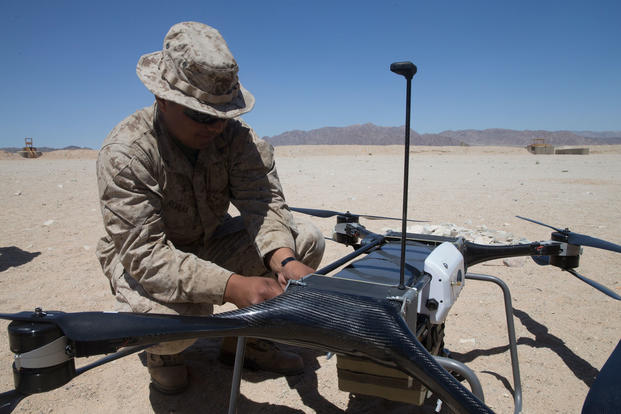A Defense Department policy memo quietly released last month has left Marine Corps infantry units unable to use the hundreds of new quadcopters fielded to units at the direction of the commandant.
The policy, which bars the purchase or use of any commercially available unmanned aerial systems (UAS), also means that off-the-shelf small drones used by public affairs troops are sitting idle.
And 3D-printed quadcopters like "The Nibbler," produced by Marines downrange, are not exempt either. While their bodies are printed on demand, their inner workings are not and may represent a security risk, according to the new memo.
Released May 23 and signed by Under Secretary of Defense Patrick Shanahan, the memo cites a May 14 Defense Department Inspector General report that found the Pentagon did not have adequate procedures to assess cybersecurity risks associated with using commercial drone systems.
Many of the most popular commercial UAS are Chinese-made, prompting concerns that they could come with embedded malware enabling the user to be surveilled or otherwise hacked.
The potential for a security breach has long been a concern for the military. In August, the Army Aviation Directorate banned the use of drones made by the most popular commercial company, DJI, which is Chinese-owned.
But the indefinite and broad-edged nature of the new DoD policy memo is likely to leave many units that have leaned into drone acquisition at the direction of their leaders sitting on their hands and without clear recourse. The ban is in place, according to the memo, "until the DoD develops a strategy to adequately assess and mitigate the risks associated with their use."
Any requests for exemptions must be approved by Shanahan himself on a case-by-case basis, and must support "urgent needs," according to the memo.
A spokesman for Marine Corps Combat Development Command, Capt. Joshua Pena, told Military.com that 600 InstantEye MK-2 Gen3 quadcopter systems have been fielded to rifle squads, with another 200 systems awaiting shipment.
The Marine Corps, he said, is in the process of requesting an exemption to allow troops to use these systems. It's not clear, however, what "urgent needs" rationale would support the request or how long it might take to obtain a waiver.
Pena said other units that own commercial UASs include science and technology elements, ground combat elements, logistics units, and public affairs.
"Right now, the priority is to request exemptions for [ground combat element] assets, to include 'Quads for Squads,' " he said.
Marine Corps Commandant Gen. Robert Neller has made getting commercial quadcopters into the hands of infantry squads a priority of his tenure as the service's top officer. The role of the miniature drones to increase Marines' awareness of their battlespace and allow them to collect information was prominent in a series of infantry experiments conducted by 3rd Battalion, 5th Marines, in 2016 and 2017.
Neller emphasized that he wanted quadcopters that were cheap and could be fielded fast, making commercial UAS the obvious solution.
And to accommodate the new technology, Neller last month announced that he had approved an overhaul of the infantry squad structure that included the creation of a new role: squad systems operator, a Marine whose focus will be operating quadcopters and other new technology.
For now, all the Marine Corps can do is wait to find out if squads will be allowed to use their new technology and resources.
"The Marine Corps is fully adhering to all DoD policies associated with [small UAS] purchase and operation," Pena said.
-- Hope Hodge Seck can be reached at hope.seck@military.com. Follow her on Twitter at @HopeSeck.









